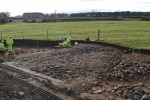 The expansion of the A1, Britain’s longest road, has unearthed a major Roman settlement at Scotch Corner in North Yorkshire. Some of the artifacts are of exceptional quality, so much so that archaeologists are having to revise their understanding of the Roman conquest of northern England. There had to have been very wealthy Romano-Britons further north and earlier than previously realized, and a Roman administrative center to boot.
The expansion of the A1, Britain’s longest road, has unearthed a major Roman settlement at Scotch Corner in North Yorkshire. Some of the artifacts are of exceptional quality, so much so that archaeologists are having to revise their understanding of the Roman conquest of northern England. There had to have been very wealthy Romano-Britons further north and earlier than previously realized, and a Roman administrative center to boot.
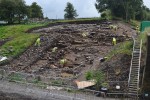 The settlement, about 40 miles north of York, was a small town by the standards of the mainland, but it was big for northern England. The site extended just under a mile from north to south and contained a mixture of Roman and native buildings. About 40 Roman buildings — rectangular and likely a combination of private homes and businesses — abutted the Roman road from London to Brigantia, the territory of the Brigantes tribe in northern England. Only 12 of them have been excavated so far. Back from the road archaeologists discovered Iron Age British roundhouses, probably the same number as the Roman structures; 14 of them have been excavated.
The settlement, about 40 miles north of York, was a small town by the standards of the mainland, but it was big for northern England. The site extended just under a mile from north to south and contained a mixture of Roman and native buildings. About 40 Roman buildings — rectangular and likely a combination of private homes and businesses — abutted the Roman road from London to Brigantia, the territory of the Brigantes tribe in northern England. Only 12 of them have been excavated so far. Back from the road archaeologists discovered Iron Age British roundhouses, probably the same number as the Roman structures; 14 of them have been excavated.
Archaeologists believe the Roman buildings were built in the 50s A.D., which means the road they face was already built or at least in the process of being built at that time. Before this discovery, historians believed it was constructed in the early 70s A.D., almost 20 years later.
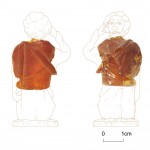 Amidst the structures and buried in votive pits, archaeologists found expensive imported artifacts including a high relief glass bowl, glazed Roman tableware, a copper mirror and drinking vessels. One of the standout pieces is an exceptionally rare fragment of a carved amber figurine. The torso of a man wearing a toga, believed to represent an actor, was likely made in Italy in the 1st century A.D., and while a similar piece has been found at Pompeii, this is the first one of its kind ever discovered in the UK. For the Scotch Corner settlement to have had artifacts like this, they had to have a line on the highest quality export goods Rome had to offer.
Amidst the structures and buried in votive pits, archaeologists found expensive imported artifacts including a high relief glass bowl, glazed Roman tableware, a copper mirror and drinking vessels. One of the standout pieces is an exceptionally rare fragment of a carved amber figurine. The torso of a man wearing a toga, believed to represent an actor, was likely made in Italy in the 1st century A.D., and while a similar piece has been found at Pompeii, this is the first one of its kind ever discovered in the UK. For the Scotch Corner settlement to have had artifacts like this, they had to have a line on the highest quality export goods Rome had to offer.
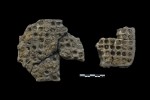 The strongest evidence that Scotch Corner was a major administrative center is the large number of pellet moulds used to create gold, silver and copper coins. Fragments of dozens of ceramic mould trays were unearthed in the area where the British roundhouses have been found. Two distinct types of trays were discovered, one for making 100 smaller pellets, another for making 50 larger ones. The pellets were the first step in coin production. The balls would then be struck with hammer and die to create coins. This is the northernmost archaeological evidence of coin production discovered in Europe.
The strongest evidence that Scotch Corner was a major administrative center is the large number of pellet moulds used to create gold, silver and copper coins. Fragments of dozens of ceramic mould trays were unearthed in the area where the British roundhouses have been found. Two distinct types of trays were discovered, one for making 100 smaller pellets, another for making 50 larger ones. The pellets were the first step in coin production. The balls would then be struck with hammer and die to create coins. This is the northernmost archaeological evidence of coin production discovered in Europe.
The moulds and alloys are characteristic of native British coin manufacture, but no Brigantian coins have ever been discovered and the scale of production indicated by the sheer number of moulds suggests the involvement of Roman administration or a massive increase in need for coinage stimulated by the Roman arrival.
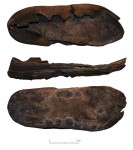 The Scotch Corner settlement predates the Roman settlements in York and Carlisle by a decade, which means the Romans established themselves in the north 10 years earlier than historians thought. It didn’t last long, however, no more than two or three decades. It was eclipsed as a population and administrative center by the neighboring settlement of Catterick (Cataractonium).
The Scotch Corner settlement predates the Roman settlements in York and Carlisle by a decade, which means the Romans established themselves in the north 10 years earlier than historians thought. It didn’t last long, however, no more than two or three decades. It was eclipsed as a population and administrative center by the neighboring settlement of Catterick (Cataractonium).
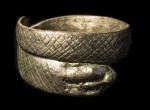 The A1 excavation has unearthed a wealth of valuable artifacts from Cataractonium as well, among them a gorgeous ring shaped like a snake; many leather shoes in excellent condition; uncut sheets of leather indicating a large-scale manufacture of shoes and clothes, possibly for the Roman army; iron keys large and small; a pewter inkpot; and a number of styli, attesting to a high level of literacy in the population.
The A1 excavation has unearthed a wealth of valuable artifacts from Cataractonium as well, among them a gorgeous ring shaped like a snake; many leather shoes in excellent condition; uncut sheets of leather indicating a large-scale manufacture of shoes and clothes, possibly for the Roman army; iron keys large and small; a pewter inkpot; and a number of styli, attesting to a high level of literacy in the population.
Neil Redfern, Principal Inspector of Ancient Monuments at Historic England said: “The sheer amount of exceptional objects found on this road scheme has been extraordinary. Through them we are learning more and more about life here in the Roman period. This project has given us a unique opportunity to understand how the Romans conducted their military expansion into Northern England and how civil life changed under their control.”